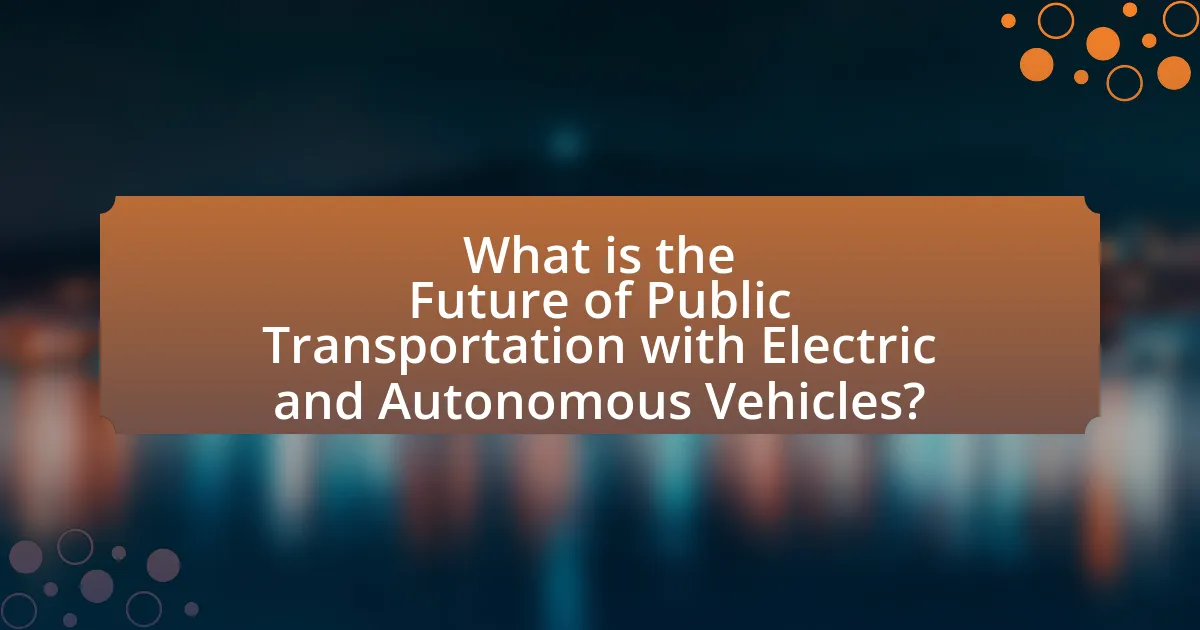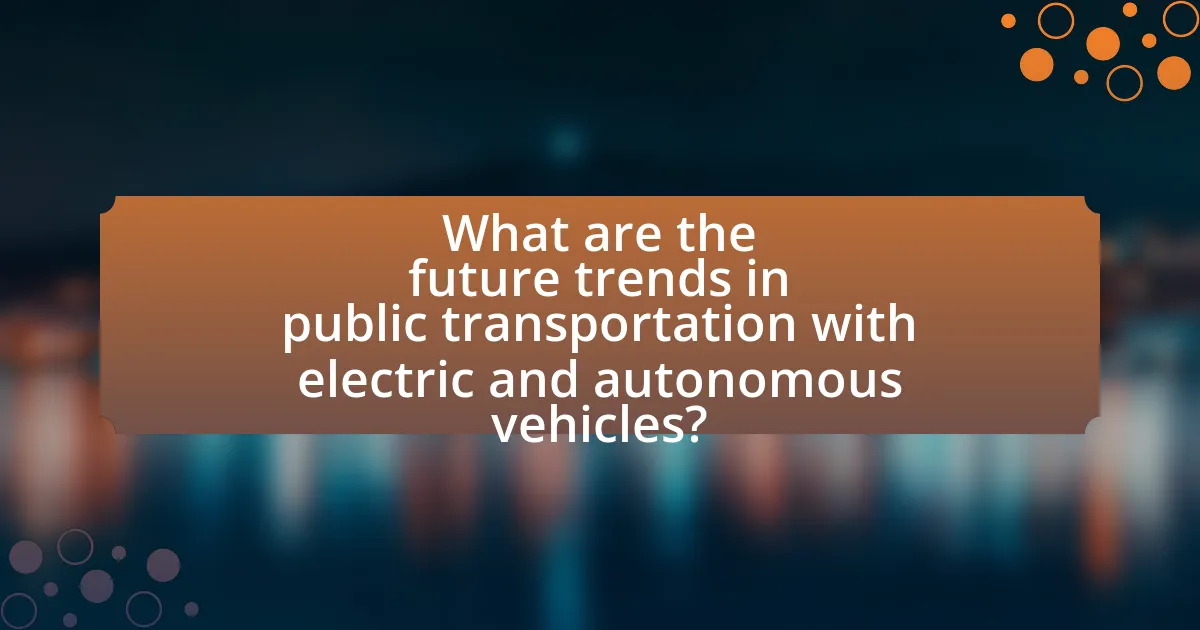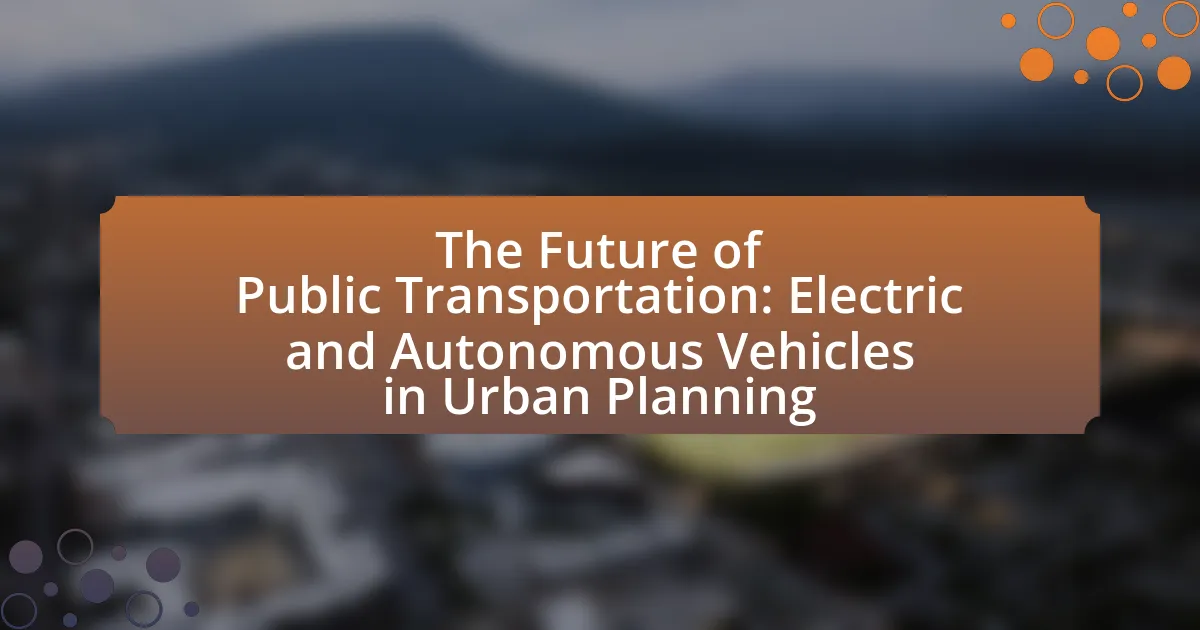The article focuses on the future of public transportation, specifically the integration of electric and autonomous vehicles within urban planning. It highlights the transformative potential of electric vehicles in reducing greenhouse gas emissions and operational costs, while autonomous vehicles enhance efficiency, accessibility, and safety in transit systems. Key features of electric public transportation vehicles, their impact on urban pollution, and the technological advancements driving autonomous systems are discussed. Additionally, the article addresses the implications for urban planning, challenges faced by planners, and the economic benefits associated with adopting these technologies, emphasizing the importance of stakeholder collaboration for successful implementation.

What is the Future of Public Transportation with Electric and Autonomous Vehicles?
The future of public transportation with electric and autonomous vehicles is poised for significant transformation, characterized by increased efficiency, reduced emissions, and enhanced accessibility. Electric vehicles (EVs) contribute to lower greenhouse gas emissions, with studies indicating that they can reduce urban transport emissions by up to 70% compared to traditional gasoline vehicles. Autonomous vehicles (AVs) promise to optimize traffic flow and reduce congestion, as they can communicate with each other and adjust routes in real-time, potentially decreasing travel times by 15-20%. Furthermore, the integration of EVs and AVs in public transit systems can improve service frequency and reliability, making public transportation a more attractive option for commuters. Cities like Los Angeles and Singapore are already piloting electric and autonomous buses, demonstrating the feasibility and benefits of this transition.
How are electric vehicles transforming public transportation?
Electric vehicles are transforming public transportation by significantly reducing greenhouse gas emissions and operational costs. The adoption of electric buses and trains leads to a decrease in air pollution, contributing to improved urban air quality. For instance, a study by the International Council on Clean Transportation found that electric buses can reduce emissions by up to 70% compared to diesel buses. Additionally, electric vehicles often have lower maintenance costs due to fewer moving parts, which can lead to savings for transit agencies. The integration of electric vehicles into public transport systems is also supported by government incentives and policies aimed at promoting sustainable urban mobility.
What are the key features of electric public transportation vehicles?
Electric public transportation vehicles are characterized by their zero-emission operation, energy efficiency, and advanced technology integration. These vehicles utilize electric powertrains, which significantly reduce greenhouse gas emissions compared to traditional diesel or gasoline-powered buses and trains. For instance, electric buses can reduce emissions by up to 80% in urban environments, contributing to improved air quality. Additionally, they often feature regenerative braking systems that capture energy during braking, enhancing overall energy efficiency. Many electric public transportation vehicles are equipped with smart technology, including real-time tracking and communication systems, which improve operational efficiency and passenger experience. These features collectively support sustainable urban mobility and align with global efforts to combat climate change.
How do electric vehicles reduce urban pollution?
Electric vehicles reduce urban pollution by eliminating tailpipe emissions, which are a significant source of air pollutants such as nitrogen oxides and particulate matter. Unlike conventional gasoline or diesel vehicles, electric vehicles operate on electricity, resulting in zero emissions during operation. According to the U.S. Environmental Protection Agency, transportation accounts for nearly 29% of total greenhouse gas emissions in the United States, and transitioning to electric vehicles can significantly lower these emissions, particularly in urban areas where vehicle density is high. Furthermore, studies indicate that widespread adoption of electric vehicles could lead to a reduction of urban air pollution levels by up to 80% in some cities, contributing to improved public health and environmental quality.
What role do autonomous vehicles play in public transportation?
Autonomous vehicles serve as a transformative element in public transportation by enhancing efficiency, accessibility, and safety. These vehicles can operate without human intervention, allowing for optimized routing and scheduling that can reduce wait times and improve service frequency. For instance, a study by the American Public Transportation Association indicates that integrating autonomous vehicles into public transit systems can lead to a 20-30% increase in operational efficiency. Furthermore, autonomous vehicles can provide transportation solutions for underserved populations, including the elderly and disabled, thereby increasing overall ridership and inclusivity in urban areas.
How do autonomous vehicles enhance safety in urban transit?
Autonomous vehicles enhance safety in urban transit by utilizing advanced sensors and algorithms to detect and respond to their environment more effectively than human drivers. These vehicles are equipped with technologies such as LIDAR, cameras, and radar, which allow them to monitor their surroundings in real-time, reducing the likelihood of accidents caused by human error. According to a study by the Insurance Institute for Highway Safety, autonomous vehicles could potentially reduce traffic fatalities by up to 90% by eliminating common causes of crashes, such as distracted driving and impaired judgment. Furthermore, autonomous systems can maintain consistent speeds and follow traffic rules more reliably, contributing to safer road conditions for all users.
What are the technological advancements driving autonomous public transport?
Technological advancements driving autonomous public transport include artificial intelligence, sensor technology, and vehicle-to-everything (V2X) communication. Artificial intelligence enables vehicles to process vast amounts of data from their surroundings, allowing for real-time decision-making and navigation. Sensor technology, such as LiDAR and cameras, provides detailed environmental mapping and obstacle detection, essential for safe operation. V2X communication facilitates interaction between vehicles and infrastructure, enhancing traffic management and safety. These advancements collectively contribute to the efficiency and reliability of autonomous public transport systems, as evidenced by pilot programs in cities like San Francisco and Singapore, which have successfully integrated these technologies into their transit networks.

What are the implications of integrating electric and autonomous vehicles in urban planning?
Integrating electric and autonomous vehicles in urban planning significantly enhances sustainability and efficiency in transportation systems. This integration reduces greenhouse gas emissions, as electric vehicles produce zero tailpipe emissions, contributing to cleaner air quality in urban areas. Furthermore, autonomous vehicles can optimize traffic flow through advanced algorithms, decreasing congestion and travel times. Studies indicate that cities implementing these technologies can experience a reduction in traffic accidents by up to 90%, as autonomous systems eliminate human error. Additionally, the shift towards electric and autonomous vehicles encourages the development of smart infrastructure, such as charging stations and dedicated lanes, which can further improve urban mobility and accessibility.
How can urban planners effectively incorporate these vehicles into existing infrastructure?
Urban planners can effectively incorporate electric and autonomous vehicles into existing infrastructure by redesigning roadways, integrating smart traffic management systems, and enhancing public transit options. Redesigning roadways involves creating dedicated lanes for these vehicles, which can improve traffic flow and safety. Smart traffic management systems utilize real-time data to optimize traffic signals and reduce congestion, facilitating smoother movement for electric and autonomous vehicles. Additionally, enhancing public transit options by integrating these vehicles into existing transit networks can provide seamless connections for users, thereby increasing overall accessibility and efficiency in urban transportation. Studies indicate that cities implementing such strategies have seen reductions in traffic delays and improvements in air quality, validating the effectiveness of these approaches.
What challenges do urban planners face with the integration of electric and autonomous vehicles?
Urban planners face significant challenges with the integration of electric and autonomous vehicles, primarily related to infrastructure adaptation, regulatory frameworks, and public acceptance. Infrastructure must be updated to accommodate charging stations and dedicated lanes for autonomous vehicles, which requires substantial investment and planning. Additionally, existing regulations may not adequately address the unique aspects of these technologies, necessitating new policies that ensure safety and efficiency. Public acceptance is also crucial, as community concerns about safety, privacy, and job displacement can hinder the adoption of these vehicles. These challenges highlight the complexity of integrating innovative transportation solutions into urban environments.
How can cities adapt their infrastructure to support these technologies?
Cities can adapt their infrastructure to support electric and autonomous vehicles by implementing dedicated lanes, upgrading charging stations, and enhancing traffic management systems. Dedicated lanes for electric and autonomous vehicles can improve traffic flow and safety, as seen in cities like San Francisco, which has integrated such lanes to facilitate smoother operations for self-driving cars. Upgrading charging stations is essential; for instance, cities like Amsterdam have installed numerous fast-charging points to accommodate the growing number of electric vehicles, ensuring accessibility and convenience for users. Additionally, enhancing traffic management systems through smart technology can optimize traffic signals and reduce congestion, as demonstrated by cities like Los Angeles, which utilizes adaptive traffic signals to improve the efficiency of vehicle movement. These adaptations are crucial for fostering an environment conducive to the integration of advanced transportation technologies.
What are the potential economic impacts of electric and autonomous public transportation?
Electric and autonomous public transportation can significantly reduce operational costs and increase economic efficiency. By utilizing electric vehicles, cities can lower fuel expenses, as electricity is generally cheaper than gasoline or diesel. For instance, a study by the American Public Transportation Association found that electric buses can save up to 70% on fuel costs compared to traditional buses. Additionally, autonomous vehicles can optimize routes and reduce labor costs associated with drivers, potentially saving municipalities millions annually. Furthermore, the implementation of these technologies can stimulate local economies by creating jobs in manufacturing, maintenance, and technology sectors, as evidenced by the projected growth of the electric vehicle market, which is expected to reach $800 billion by 2027 according to a report by Allied Market Research. Overall, the transition to electric and autonomous public transportation presents a multifaceted opportunity for economic growth and cost savings.
How can these technologies create job opportunities in urban areas?
Electric and autonomous vehicles can create job opportunities in urban areas by fostering new industries and enhancing existing ones. The deployment of electric vehicles requires skilled workers for manufacturing, maintenance, and charging infrastructure installation, which can lead to job creation in automotive and energy sectors. Additionally, autonomous vehicle technology necessitates roles in software development, data analysis, and cybersecurity, contributing to the growth of tech jobs. According to a report by the International Transport Forum, the shift to electric and autonomous vehicles could generate up to 1.5 million jobs in the United States alone by 2030, highlighting the significant employment potential associated with these technologies.
What cost savings can municipalities expect from adopting electric and autonomous vehicles?
Municipalities can expect significant cost savings from adopting electric and autonomous vehicles, primarily through reduced fuel and maintenance expenses. Electric vehicles (EVs) typically have lower operating costs compared to traditional gasoline vehicles, with estimates indicating that EVs can save municipalities up to 60% on fuel costs due to lower electricity prices and higher energy efficiency. Additionally, autonomous vehicles can optimize routes and reduce labor costs associated with human drivers, potentially saving municipalities millions annually. A study by the American Public Transportation Association found that transitioning to electric buses alone could save municipalities approximately $400,000 per bus over its lifetime when considering fuel and maintenance savings.

What are the future trends in public transportation with electric and autonomous vehicles?
Future trends in public transportation with electric and autonomous vehicles include increased adoption of electric buses and shuttles, integration of autonomous ride-sharing services, and the development of smart infrastructure to support these technologies. Cities are investing in electric vehicle fleets to reduce emissions; for instance, the International Energy Agency reported that electric buses accounted for 20% of global bus sales in 2020. Additionally, autonomous vehicles are expected to enhance efficiency and accessibility, with companies like Waymo and Tesla leading pilot programs in urban areas. The shift towards these technologies is also supported by government policies promoting sustainability and innovation in transportation systems.
How will consumer behavior influence the adoption of these technologies?
Consumer behavior will significantly influence the adoption of electric and autonomous vehicles in public transportation by determining demand, acceptance, and usage patterns. As consumers increasingly prioritize sustainability and convenience, their preferences will drive public transit agencies to invest in these technologies. For instance, a 2021 survey by the International Council on Clean Transportation found that 70% of respondents expressed a willingness to use electric buses if they were available, indicating a strong consumer interest in eco-friendly options. Additionally, consumer concerns about safety and reliability will shape the acceptance of autonomous vehicles; studies show that perceived safety directly impacts willingness to adopt new technologies. Thus, understanding consumer behavior is crucial for effectively implementing electric and autonomous vehicles in urban planning.
What factors motivate users to switch to electric and autonomous public transport?
Users are motivated to switch to electric and autonomous public transport primarily due to environmental concerns, cost savings, and enhanced convenience. Environmental concerns drive users to seek sustainable alternatives, as electric vehicles produce lower emissions compared to traditional fossil fuel-powered transport. Cost savings are evident in reduced fuel and maintenance expenses associated with electric vehicles, which can lead to lower overall transportation costs for users. Enhanced convenience arises from the efficiency and reliability of autonomous systems, which can optimize routes and reduce wait times, making public transport more appealing. According to a study by the International Council on Clean Transportation, electric buses can reduce greenhouse gas emissions by up to 70% compared to diesel buses, reinforcing the environmental benefits that motivate users to make the switch.
How can public awareness campaigns enhance acceptance of these vehicles?
Public awareness campaigns can enhance acceptance of electric and autonomous vehicles by educating the public about their benefits, addressing misconceptions, and promoting positive narratives. These campaigns can inform potential users about the environmental advantages, such as reduced emissions and improved air quality, which are supported by studies indicating that electric vehicles can significantly lower greenhouse gas emissions compared to traditional vehicles. Additionally, awareness campaigns can highlight the safety features and technological advancements of autonomous vehicles, which research shows can reduce traffic accidents by up to 90% when fully implemented. By fostering a better understanding of these vehicles, public awareness campaigns can build trust and encourage adoption among urban populations.
What best practices should cities follow when implementing electric and autonomous public transportation?
Cities should prioritize comprehensive planning and stakeholder engagement when implementing electric and autonomous public transportation. Effective planning involves assessing current transportation needs, infrastructure capabilities, and potential environmental impacts. Engaging stakeholders, including community members, transportation experts, and local businesses, ensures that the system meets diverse needs and gains public support.
Additionally, cities should invest in robust charging infrastructure to support electric vehicles, as studies indicate that adequate charging stations significantly enhance the adoption of electric public transport. For instance, a report by the International Council on Clean Transportation highlights that cities with extensive charging networks see higher usage rates of electric buses.
Furthermore, cities must implement safety regulations and testing protocols for autonomous vehicles to ensure public safety and build trust in the technology. The National Highway Traffic Safety Administration emphasizes that rigorous testing and transparent reporting of autonomous vehicle performance are crucial for public acceptance.
Lastly, integrating electric and autonomous systems with existing public transport networks can enhance efficiency and user experience, as demonstrated by successful models in cities like San Francisco and Amsterdam, where seamless connections between different transport modes have led to increased ridership.
What lessons can be learned from cities that have successfully integrated these technologies?
Cities that have successfully integrated electric and autonomous vehicles demonstrate the importance of comprehensive planning and stakeholder engagement. For instance, cities like San Francisco and Amsterdam have shown that involving local communities, businesses, and government agencies in the planning process leads to more effective implementation and acceptance of new technologies. Additionally, these cities highlight the necessity of investing in infrastructure, such as dedicated lanes and charging stations, to support electric vehicles and ensure safety for autonomous systems. Data from the International Transport Forum indicates that cities with robust public transportation systems that incorporate these technologies experience a reduction in traffic congestion and improved air quality, reinforcing the benefits of strategic integration.
How can collaboration between stakeholders improve implementation outcomes?
Collaboration between stakeholders can significantly improve implementation outcomes by fostering shared goals, enhancing resource allocation, and facilitating knowledge exchange. When various stakeholders, such as government agencies, private companies, and community organizations, work together, they can align their objectives, ensuring that projects meet the needs of all parties involved. For instance, a study by the Transportation Research Board highlights that collaborative planning in urban transportation projects leads to more efficient use of funds and better project delivery timelines. Additionally, collaboration allows for pooling of expertise and resources, which can lead to innovative solutions and improved project sustainability. This synergy ultimately results in more effective implementation of electric and autonomous vehicle initiatives in urban planning.
